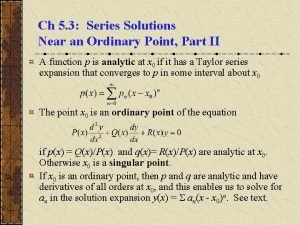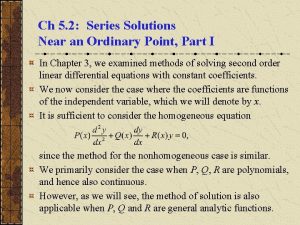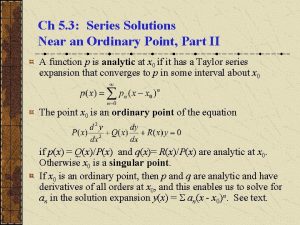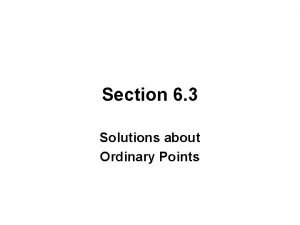Ch 5 3 Series Solutions Near an Ordinary







- Slides: 7

Ch 5. 3: Series Solutions Near an Ordinary Point, Part II A function p is analytic at x 0 if it has a Taylor series expansion that converges to p in some interval about x 0 The point x 0 is an ordinary point of the equation if p(x) = Q(x)/P(x) and q(x)= R(x)/P(x) are analytic at x 0. Otherwise x 0 is a singular point. If x 0 is an ordinary point, then p and q are analytic and have derivatives of all orders at x 0, and this enables us to solve for an in the solution expansion y(x) = an(x - x 0)n. See text.

Theorem 5. 3. 1 If x 0 is an ordinary point of the differential equation the general solution for this equation is where a 0 and a 1 are arbitrary, and y 1, y 2 are linearly independent series solutions that are analytic at x 0. Further, the radius of convergence for each of the series solutions y 1 and y 2 is at least as large as the minimum of the radii of convergence of the series for p and q.

Radius of Convergence Thus if x 0 is an ordinary point of the differential equation, then there exists a series solution y(x) = an(x - x 0)n. Further, the radius of convergence of the series solution is at least as large as the minimum of the radii of convergence of the series for p and q. These radii of convergence can be found in two ways: 1. Find the series for p and q, and then determine their radii of convergence using a convergence test. 2. If P, Q and R are polynomials with no common factors, then it can be shown that Q/P and R/P are analytic at x 0 if P(x 0) 0, and the radius of convergence of the power series for Q/P and R/P about x 0 is the distance to the nearest zero of P (including complex zeros).

Example 1 Let f (x) = (1 + x 2)-1. Find the radius of convergence of the Taylor series of f about x 0 = 0. The Taylor series of f about x 0 = 0 is Using the ratio test, we have Thus the radius of convergence is = 1. Alternatively, note that the zeros of 1 + x 2 are x = i. Since the distance in the complex plane from 0 to i or –i is 1, we see again that = 1.

Example 3: Airy’s Equation Determine a lower bound for the radius of convergence of the series solution about x 0 = 1 for the equation Here, P(x) = 1, Q(x) = 0, R(x) = - x. Thus every point x is an ordinary point, because p(x) = 0 and q(x) = - x are both analytic everywhere. Thus the radius of convergence for p and q is infinite. Therefore, by Theorem 5. 3. 1, the radius of convergence for the series solution about x 0 = 1 is infinite.

Example 5: Legendre Equation (1 of 2) Determine a lower bound for the radius of convergence of the series solution about x 0 = 0 for the Legendre equation Here, P(x) = 1 – x 2, Q(x) = -2 x, R(x) = ( + 1). Thus x 0 = 0 is an ordinary point, since p(x) = -2 x/(1 – x 2) and q(x) = ( + 1)/(1 – x 2) are analytic at x 0 = 0. Also, p and q have singular points at x = 1. Thus the radius of convergence for the Taylor series expansions of p and q about x 0 = 0 is = 1. Therefore, by Theorem 5. 3. 1, the radius of convergence for the series solution about x 0 = 0 is at least = 1.

Example 5: Legendre Equation (2 of 2) Thus, for the Legendre equation the radius of convergence for the series solution about x 0 = 0 is at least = 1. It can be shown that if is a positive integer, then one of the series solutions terminates after a finite number of terms, and hence converges for all x, not just for |x| < 1.













